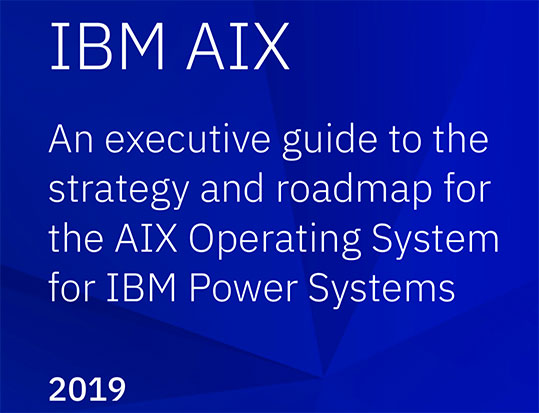Ron Gordon
Director » Power Systems
I have heard concerns that IBM is trending away from AIX. Just recently, IBM released a document titled IIBM AIX – An executive guide to the strategy and roadmap for the AIX Operating System for IBM Power Systems. I believe that this guide from IBM is needed, as the many thousands of AIX users on IBM Power Systems seem to have concerns over IBM’s latest acquisition of Red Hat and the focus on Open Source software, Artificial Intelligence, and Cloud solutions, which are primarily Linux-based. I have even seen comments like, “this must mean the end of AIX.” I spend a lot of time talking with the AIX and Power development teams, I do not share in the opinion “AIX is dead.” In fact, I feel quite the opposite.
To quote from the IBM AIX strategy paper, “The strategic direction of AIX is to continue innovating for the needs of the AIX community today, while embracing new technologies and IT landscape trends for tomorrow. IBM Power Systems with AIX is well-positioned to meet the demands of your most critical data and business production workloads.” And, “IBM is committed to the thousands of AIX users running their core, mission-critical business applications and databases on AIX.” Those are very strong statements and should give you confidence that your investment in AIX and AIX-skilled resources will be preserved.
If we look back over the years, even the most recent years, IBM has demonstrated their commitment to the IBM AIX Operating System by keeping up with customer requirements, systems requirements, and technology advancement. Since the initial AIX release in 1986, IBM development teams have added and enhanced AIX in areas of performance (SMT, ASO, DSO); analysis (NMON); virtualization (DLPARs); security (Security Expert, encrypted file systems); diagnostics (Probvue); Open Source (AIX toolbox for Linux); and management (live update, integration with PowerVM, PowerSC, PowerHA). And, the IBM development team is not done.
IBM AIX History
A little history, while I am at it. AIX was originally developed by IBM and Interactive Systems Corporation and first released in 1986. Interactive Systems Corporation had previously developed the System 370 Unix operating system, then called IX/370. The joint work with IBM was designed as a high-performance Unix for the IBM RT PC Workstation, and later, under just IBM development, became the Operating System for the IBM RS/6000 systems, as well as others like the Apple Network Server and the IBM PS/2 personal computer. For certain, this development advanced to the IBM Power Systems of today.
The IBM AIX OS was originally based on UNIX System V with 4.3 BSD-compatible extensions. The name AIX stands for Advanced Interactive eXecutive, which is partially derived from the Interactive Systems Corporation name. AIX does NOT stand for AIX en Provence, a town in France, where AIX is French for water or aqua. Some AIX people, when in France, like to be photographed by the AIX en Provence town name. But, don’t be fooled: The French invented many things, but they did not invent AIX.
AIX Commitment Highlights
With that background, I think you can see that AIX has a long history and has come a long way since 1986. As IBM moves forward, we can see several points that are made in the IBM AIX executive guide, which I believe demonstrate the commitment and continued development of AIX. At a high level, those points are:
1) Commitment to innovate and expand AIX
2) Commitment for AIX to enable modernization of the IT environment
3) Commitment to surround AIX with efficient management tooling
Point 1: Innovate and Expand
We have seen and will see more in the commitment to integration of OpenSource. I see this expanding into more Ansible playbooks and Chef recipes. I see increased security being integrated directly into AIX, along with enhanced support being developed right now for the coming POWER10-based systems. And, to enable expansion beyond the IBM teams, we can see that IBM recently open sourced the PPC ISA, which may enable expansion beyond the IBM borders.
Point 2: IT Modernization and AIX
Modernization today is the concept of moving into new development methodologies (containers) and the ability to integrate cloud into the organization, to enable new computing models that are on demand and selectively cost reducing. The ability of AIX to run side by side with Linux and for AIX virtual machines, as well as now in the IBM cloud using seamless interfaces for virtual machine placement, is part of the IBM strategy with AIX.
Point 3: Surround AIX with Management Tools
AIX cannot (and should not) do it all. Management of the environment, however, also needs to keep up with technology and IT needs. Advancements and new features in PowerVM, PowerVC, PowerSC, and PowerHA are part of the plan to enable entire IT infrastructures to move forward, as part of modernization and expanding business requirements. This is also part of the AIX strategy.
AIX Innovation Use Cases
To me, use cases bring it all home since technology is not worth much unless it enables business results. IBM does a good job highlighting AIX innovation from around the globe, including solutions such as SAP, IBM MQ, Oracle, and others.
Other significant messages in the strategy paper include:
- The future of AI on AIX
- Cloud
- Security
- AIX roadmap to 2030
The strategy guide can be downloaded here.
Conclusion
IBM’s commitment to AIX continues to be steadfast, and it demonstrates that IBM Power Systems with AIX is a solid, future-proof foundation to support your growing business needs.
For more information on IBM Power Systems, please contact your Mainline Account Executive, or click here to contact us with any questions.
Related Blogs and Videos
Blog: IBM Power Systems Strategy
Blog: My Reflections on Power Systems Topics at IBM Think 2019
Video: Artificial Intelligence on Power Systems

